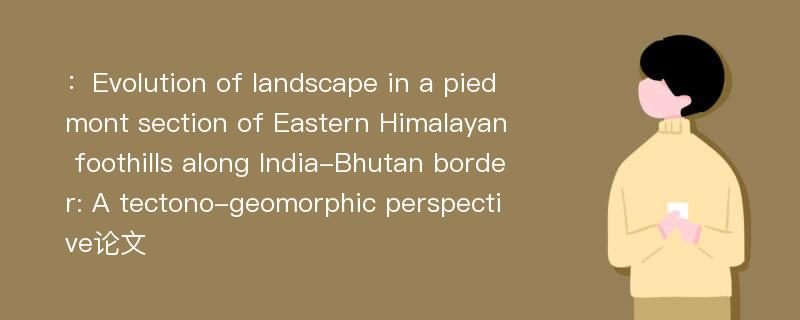
本文主要研究内容
作者(2019)在《Evolution of landscape in a piedmont section of Eastern Himalayan foothills along India-Bhutan border: A tectono-geomorphic perspective》一文中研究指出:The present study area involves part of a deformed coalesced fan located along the Himalayan Frontal Thrust(HFT) on the east of river Tista near the India-Bhutan border. The area is marked by two spectacular E-W trending south-sloping scarps namely the Matiali(ca. 60 m) and Chalsa(ca. 90 m)Scarps and a north-sloping E-W trending Thaljhora(ca. 80 m) Scarp. Our work comprises of a comparative study of geomorphology and geologic history in the adjacent interfluves of Jaldhaka-Gathia and Neora-Murti rivers to understand the tectonic history of the area. We mapped the Jaldhaka-Gathia river interfluve at a 1:25,000 scale and report a hitherto unidentified northerly sloping small scarp of ca. 5 m height named the Nagrakata Scarp. This scarp was identified using satellite images, DEMs, and total station survey. We interpret that the two northsloping, E-W trending scarps(Thaljhora and Nagrakata Scarps) are manifestations of steep limbs of anticlines over blind south-dipping back thrusts.Together they form a wrinkle-ridge pair behind the north-dipping HFT, which is manifested by south-sloping Chalsa Scarp. We propose a plausible geomorphic model interpreting that deformation along the small fan in the Jaldhaka-Gathia interfluves is younger compared to fan deposition and deformation in the adjacent Mal-Murti interfluve. The most recent geomorphology of the Jaldhaka-Gathia interfluve is controlled by tectonism associated with the thrust below the Nagrakata Scarp where the youngest deformation episode is recorded to at around ~6 ka and is likely related to motion on a splay off of the thrust beneath the Thaljhora Scarp.
Abstract
The present study area involves part of a deformed coalesced fan located along the Himalayan Frontal Thrust(HFT) on the east of river Tista near the India-Bhutan border. The area is marked by two spectacular E-W trending south-sloping scarps namely the Matiali(ca. 60 m) and Chalsa(ca. 90 m)Scarps and a north-sloping E-W trending Thaljhora(ca. 80 m) Scarp. Our work comprises of a comparative study of geomorphology and geologic history in the adjacent interfluves of Jaldhaka-Gathia and Neora-Murti rivers to understand the tectonic history of the area. We mapped the Jaldhaka-Gathia river interfluve at a 1:25,000 scale and report a hitherto unidentified northerly sloping small scarp of ca. 5 m height named the Nagrakata Scarp. This scarp was identified using satellite images, DEMs, and total station survey. We interpret that the two northsloping, E-W trending scarps(Thaljhora and Nagrakata Scarps) are manifestations of steep limbs of anticlines over blind south-dipping back thrusts.Together they form a wrinkle-ridge pair behind the north-dipping HFT, which is manifested by south-sloping Chalsa Scarp. We propose a plausible geomorphic model interpreting that deformation along the small fan in the Jaldhaka-Gathia interfluves is younger compared to fan deposition and deformation in the adjacent Mal-Murti interfluve. The most recent geomorphology of the Jaldhaka-Gathia interfluve is controlled by tectonism associated with the thrust below the Nagrakata Scarp where the youngest deformation episode is recorded to at around ~6 ka and is likely related to motion on a splay off of the thrust beneath the Thaljhora Scarp.
论文参考文献
论文详细介绍
论文作者分别是来自Journal of Mountain Science的,发表于刊物Journal of Mountain Science2019年12期论文,是一篇关于,Journal of Mountain Science2019年12期论文的文章。本文可供学术参考使用,各位学者可以免费参考阅读下载,文章观点不代表本站观点,资料来自Journal of Mountain Science2019年12期论文网站,若本站收录的文献无意侵犯了您的著作版权,请联系我们删除。
